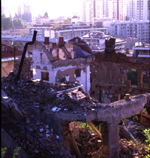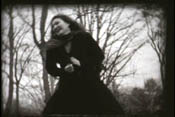Reflections on the film “Picture Me an Enemy”
http://www.visavisproductions.com/
Film synopsis (from the above website):
When the war started, we thought it was simply impossible.
What, am I supposed to expect my first neighbor to come and kill me?
Oh, come on it's not possible! But it is very possible and it happened.
Tahija Vikalo (1998)
| In 1991, war broke out in the former Yugoslavia. The ensuing conflicts left up to a quarter of a million people dead or missing in the region and made refugees of more than half of the national population of Bosnia & Herzegovina. And despite wide international attention, understanding of these conflicts is still vague and detached.
|

|
|
|
With candid and revealing perspectives rarely seen on the evening news, Tahija and Natasa provide new insights into these, often-misunderstood, conflicts. And although the documentary focuses on the conflicts of the former Yugoslavia, the themes raised within, reach far beyond the borders of any one country.
|
| Shot in Philadelphia and the former Yugoslavia, Picture Me an Enemy inter-cuts archival news footage and abstract Super 8 vignettes with the post-war reflections of Tahija and Natasa in a style that is both engaging and sincere. This is supplemented with archival footage from the war and a wealth of images of the people and places of the former Yugoslavia. Award-winning editor Barbara Burst combines these elements in an engaging and sincere way. Blending sounds from East, West, folk and pop, the film's soundtrack features the music of diaSonic, an international act recently featured on MTV and Fox Television. The musicians, Milan Kovacev and Damir Prcic, who, like Tahija and Natasa, come from opposing sides of the conflict in the former Yugoslavia, find a common ground through music by combining classical, hip hop and electronic dance music with folk songs from Serbia and Bosnia. |
| This documentary is especially unique because of the visibly sincere friendship developed over six years between the vis à vis productions crew and Tahija & Natasa. As they share their experiences, the viewer is introduced to the images, humor, culture and life of the former Yugoslavia in an up close and intimate way. |
|
| The target audience for Picture Me an Enemy is people who care little about issues of war and conflict, and would rarely ever sit down to watch a "war documentary." Although told through the voices of two women from the former Yugoslavia, the themes raised throughout Picture Me an Enemy reach far beyond the borders of any one country. At its core, this is a story of two women who have the same fears, hopes and dreams as women anywhere. | |
This film was screened as part of a Bosnia symposium at my college, and was also part of the curriculum for a freshman course on the Bosnian war for which I was a TA. I thought this was an excellent film that exemplified the complicated, category-defying classification of ethnic groups in Bosnia. After traveling to Bosnia four times and contemplating the complex role ethnicity played in the war, the only thing I am completely sure of is that nothing is certain. The Bosnian conflict is so difficult, so intriguing, and so important because it was not a clear-cut matter of black and white/good guys vs. bad guys. Rather, it seems that every side is a shade of gray, and I can’t unqualifiedly label any one group as the “good guys.”
Moreover, it seems that each person you ask lays the blame for what happened elsewhere. For example, when I was in Mostar in 2004, our Bosnian Muslim trip hostess told us that during the war, the Croats and Muslims of Mostar had banded together against the Serb aggressors. When the Serbs were no longer a threat, she said, the Croats turned on the Muslims with no reason and started shooting at them.
That summer, I was speaking to an American man who does mission work in Bosnia through a Catholic relief organization and works primarily with Bosnian Croats. When I mentioned Mostar, he told me that he had heard how the Croats and Muslims banded together against the Serbs until the Muslims irrationally turned on the Croats and started shooting. It’s hard to know what the truth of the matter actually is.
The thing that struck me most about the video was when Tahija commented that people are always saying to her “No! You’re Muslim? You can’t be Muslim!” Most of the interpreters we work with in Bosnia are Muslim, and I have to admit that before I met them, the concept of a blonde, liberal European Muslim girl who speaks English, wants to live in America, dresses like me, and knows more about American pop culture than I do was a little startling. Many Americans tend to at best see all Muslims as Middle-Eastern/Arab and traditional, and at worst see all Muslims as terrorists or Islamist extremists. In the girl in the video, I not only saw my friends from Sarajevo, I saw my girlfriends in New Jersey.
A film like this makes it apparent that there were ordinary people on every side, girls my age who dress like me and think like me and aren’t irrational or full of hate. Most of the people swept up by the conflict were simply ordinary people. It must be very hard for Bosnians like the two girls in the video not to fall into the trap of thinking of each other in such unambiguous right and wrong/good and evil terms.





